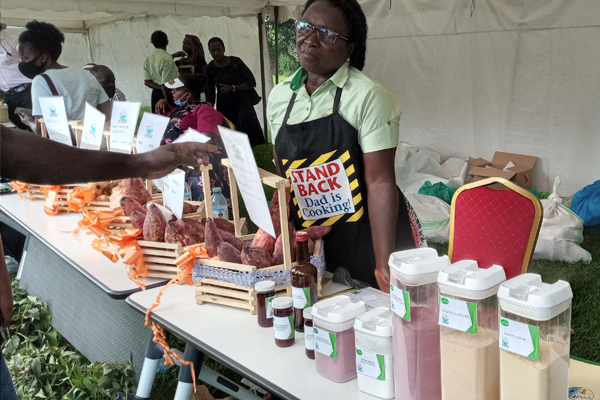‘Sweet’ purple potato science

Researchers display value-added products from sweet potatoes. Photo / Lominda Afedraru.
What you need to know:
- Gaining in popularity across the world, the purple sweet potato variety, is one of the darlings of food-savvy people – they are delicious and nutritious.
Sweet potato ranks fifth among the world’s most important crops and is vital in all countries of eastern Africa.
It is mostly grown as a subsistence crop by resource poor farmers in a non-seed carbohydrate staple food system
In Uganda, it is a major staple food along with banana, cassava and Irish potato, often in combination with beans and vegetables.
It is cultivated in all agro ecological zones and performs well in marginal soils. Sweet potato is high in carbohydrates and vitamin A and is crucial during the harsh dry periods when people depend on the crop to combat hunger
During the early 1990s, the production of cassava declined due to Cassava Mosaic virus and the production of banana dropped because of black Sigatoka disease and banana weevil infestation.
So food supply was inadequate often resulting in famine and dependence on relief aid for survival.
Meanwhile, sweet potato established itself in the food system, meeting people’s nutritional requirements and for covering recurrent household expenses.
This led to many farmers in Eastern Uganda in the districts of Kumi and Soroti growing sweet potato as a cash crop for commercial markets and becoming the main suppliers for the market of Kampala.
However, agricultural scientists at the National Research Organisation (Naro) have since realised that the traditional sweet potato varieties farmers are growing lack a number of food nutrients and they have bred varieties that are rich in vitamin A, zinc, iron and other mineral nutrients.
Sweet potato varieties
So far Naro has released 27 varieties of sweet potato varieties with varying characteristics and attributes which farmers are growing in various parts of the country
Farmers tend to prefer varieties that have high dry matter. The most predominant skin colours are white and pinkish while the flesh colours are mostly yellow and orange.
Outstanding sweet potato traditional varieties grown in Uganda include Tanzania, Tororo 3, New Kawogo and Kakamega.
The orange fleshed varieties include NASPOT8, 11, 12, 13 and NAROSPOT1, 2, 3 and 5. The varieties have good storage root, high dry matter content, high level of beta-carotene and are resistant to sweet potato virus.
Dr Agnes Alajo, a sweet potato breeder at the National Crops Resources Research Institute (NaCRRI), explains that the breeding of purple-fleshed sweet potato variety is aimed at obtaining health benefits compared to other varieties.
“They are rich in Vitamin A. They act as antioxidants fighting diseases which are likely to attack the body and they offer anti-inflammatory, anti-viral and anti-cancer benefits,” said Alajo.
Breeding process
According to Alajo, the purple fleshed sweet potato breeding programme started in 2014.
This involved collecting the local varieties which originally contained light purple colour namely Tumumesa found in Teso region and Kikuyu, which is mainly grown by farmers in Mbale.
The team picked the vines with natural purple colour which were propagated vegetatively and crossed to varieties provided by scientists from North Carolina State University in USA.
However, apart from cutting the vines and planting, scientists grow newly shooting vines from sweet potato tuber by leaving it lying on soil for a specified period time until it develops vines.
Ms Alajo and team after growing the vines at the institute and making selections of varieties with deep purple tubers extended the breeding for multi locational trials which are being conducted in Rwebitaba Zonal Agricultural Research and Development Institute, Abi Zonal Agricultural Research and Development Institute, Arua and NaCRRI in Namulonge.
Alajo contends that the plants are growing well because they are tolerant to drought and sweet potato weevils considered deadly in farmer fields across the country. The team is set to release them for farm use in 2022.
The intention of the scientists in breeding this variety is to provide a remedy for food security and chronic diseases because the research shows this variety can prevent cancer, ulcers and cardiovascular diseases and enhancing vision.
Other varieties that have undergone trials which are ready for release are NKB135 RICH in beta carotene and NKB216 which is good for food, processing flour and rich in starch.
Value addition
The scientists have proved that the purpled fleshed sweet potato variety is good for processing flour which can be used in the confectionery industry for baking cakes, biscuits as well as for making juice.
It can also be a source of natural food colourants as opposed to the synthetic ones and the processed purple-fleshed sweet potato chips and crisps has much longer shelf life compared to many other products made from root crops.
Pharmaceutical industries are privileged to use the flour for colouration of drugs as well as food colouration to make it look attractive for consumption.
Diversity
Farmers either plant sweet potatoes on mounds or on ridges using vine cuttings. Vines are the mature stems and are taken from the shoot. A good vine cutting should be about one foot long or about 6 nodes and should be disease-free.When mounds are used, they should not exceed a height of 1m in height and diameter.




